Benoit |The Definition of a Paris Bistro
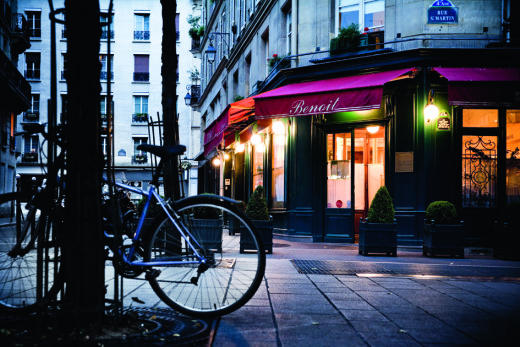
@ Pierre Monetta
Paris without Benoit, a wonderful old bistro on the edge of the Marais that’s been in business since 1912, would be almost as unimaginable to me as Paris without the Eiffel Tower. Why? Though I’ve occasionally had a bone or two to pick with Benoit through the years, it remains an august monument to the eternal goodness of Parisian bistro cooking. And that’s why today I’m grateful to Alain Ducasse for taking it over in 2005. I was a bit skeptical at the time–after all, what could Ducasse bring to a bistro register as brilliant as the one perpetuated by the Petit family for 93 years? Not much, as it turned out, but in his quiet role as a restaurant curator and collector, he saved this place.
Without Ducasse, Benoit might have suffered the same ignominious fate as Le Grizzli, a once charming old-fashioned Auvergnat bistro across the street where I used to love the fricot de veau (veal stew with wild mushrooms) that’s now become an insipid could-be-just-about-anywhere type of table–I mean, does anyone really come to Paris to eat skewered chicken with sate sauce?
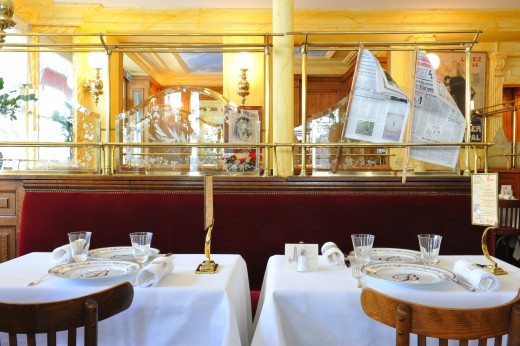
@ C. Sarramon
My most recent meal at Benoit was born of a heart-felt desire to lift the spirits of a much-loved friend, a longtime American resident of Paris like me, who’s going through a very hard time. Aside from daily phone calls, I was trying to think of what I could do to cheer her up, to distract her, and then it occurred to me that a really good meal with some great wines would be perfect. So I invited her to join me at Benoit.
On the way to dinner, it was a soft Paris night in May when the air was scented by chestnut flowers, a distinct but soft and fleetingly floral moment in the city’s annual calendar that never lasts more than a few days, and I thought of the first time I went to dinner at Benoit, with Ken, a handsome guy from the corn-belt in Ohio who used to work for the same company I did. He liked to eat as much as I do, and we drank a what-the-hell expensive bottle of Cote Rotie with our meal, which wasn’t a long-planned event, but rather an off-the-cuff let’s-go-out-to-dinner feast before obligatory reservations strangled such spontaneous pleasures. Yes, there really was a time in Paris where you could walk in the door of a very good restaurant in Paris and get a table. What a shame it is that meal planning has become as strategic, intricate and carefully plotted as D-Day.
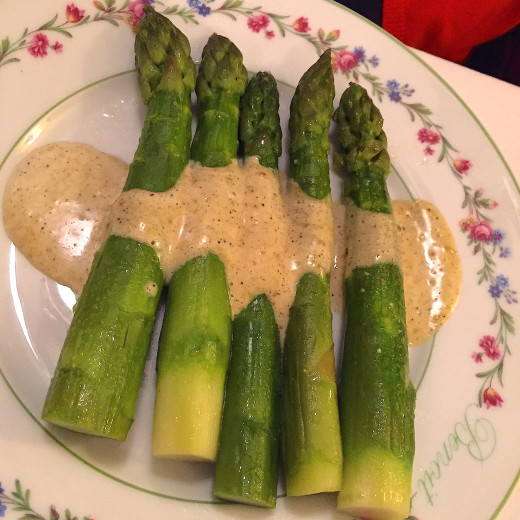
What was racketing around in my head on the way to dinner was my recurring exasperation with several of the most exhausted cliches of contemporary food writing, to wit, women love salad and fish, while men want meat and more meat, and younger people don’t want traditional French bistro food like older ones do but would rather have pizza, sushi and cheeseburgers. None of these ideas are true, actually, but their persistent existence throws any discussion about good food in Paris way off course. Many of the women I know and love are even more enthusiastic eaters of offal and big bloody steaks than I am, and a good number of my youngest friends crave blanquette de veau and coq au vin even more than I do. So do you care to guess which one of us ordered the asparagus with a truffled mousseline sauce?
Well, we both did, but that was after we’d shared an order of Langue de Lucullus, a speciality of Valenciennes in northern France comprised of fine layers of smoked tongue interleaved with pork-liver pate; it’s a dish I never eat without thinking of Bruno’s lovely mother, who now insists I call her “Maman,” because I’m her ‘American son,’ since she was the one who introduced it to me. It’s sturdy old-fashioned French food, and as much as I love it it always induces an apprehension that I might soon be a worthy model for Rodin, the sculptor of large solid people, if he were still alive.
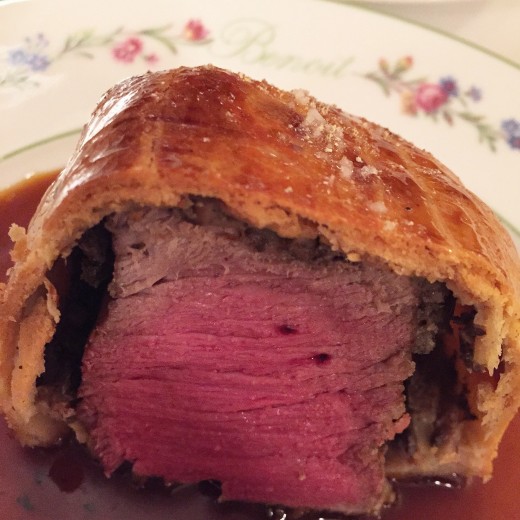
There were ever so many tempting things on the menu at Benoit the other night, but what caught my eye, oddly, was Boeuf Wellington, that ur American suburban dinner-party show-off recipe from the Seventies, which consists of a filet of beef anointed with a sauce Perigueux (foie gras and truffles) wrapped in pastry. I hadn’t eaten Beef Wellington in beyond the nets of recent memory, but since it’s served here for two (until the end of May 2015, as part of a tiny collection of wonderfully retro recipes) I had to be sure my friend was onboard as well.
She was, so we did, and it was wonderful, because the beef wasn’t the insipid filet most often found in the same preparation in North America, where tenderness is the ultimate and rather sorry measure of good meat, but juicy mineral-rich French beef with a pleasantly chewy grain. And as I ate it, I thought of the long butterfly-print culotte halter dress that my mother wore with tangerine sandals when she wanted to buck back against a world of make-up-free suburban women in wrap skirts with the same bob haircuts they’d had since they were twelve. Mind you, my mother was all scorn (and still is) when it comes to anything that might be construed as feminine wiles, but she still occasionally felt the need or desire for a little bit of glamour, a timeout from the spaded femininity of American suburbs in the Northeast in the sixties and seventies, and it’s true I’ve never ever known a man who looked at a metal duck-head belt buckle, one of the embarrassing emblems of female preppy privilege, and gone wild with desire
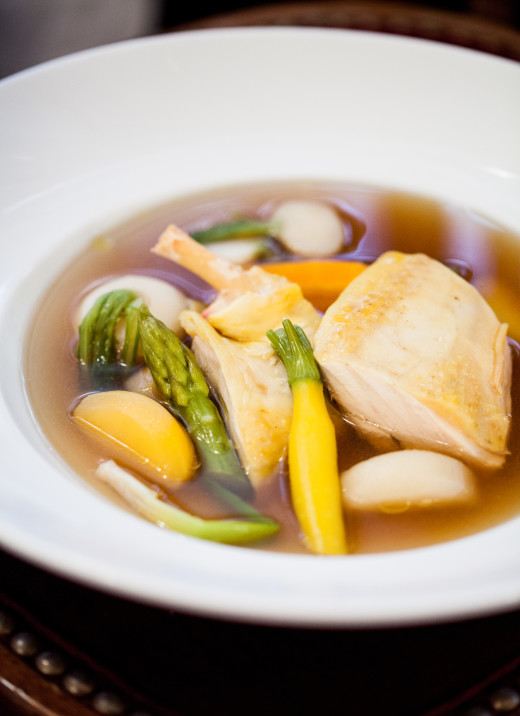
poule au pot @ pierre moneetta
So certain dishes become repositories of memory in all cities, all countries and all cultures. And this was why it was so poignant to eat Beef Wellington at Benoit–it fused France and America in a gentle subconscious soup of happy memory for two gastronomically exigent American expatriates (and I’d still insist that I’m not an expatriate, but rather an American whose curiosity led him to chose a life abroad). Mind you, the impulse could have gone very wrong if the dish hadn’t been so beautifully prepared–and this is Benoit’s glory, it’s Vieille France glorified by exquisite modern cooking methods and the exalted sourcing of the best Gallic produce.
Mind you, it’s expensive, and the service is still organised according to an unspoken and not always accurate table plan of snobbery that these days is probably snubbing some of the most interesting people in the room. To wit, people who still dress up get seats in the prized corral in the heart of the restaurant, those who are deemed runners up sit up front in the area adjacent to the bar, and everyone else is sent to the backroom, a dull dining room that was one of my bones to pick with Ducasse when he took this place over. The decision was all business, and it blunted the restaurant’s charm.
Benoit is still the kind of place, though, where you might have a gracious and unexpected surprise during dinner. The beautiful woman from Manila sitting next to us with her American husband insisted we try some of her luscious poule au pot, because she couldn’t finish it but must have been sporadically listening to our frenetic chatter about good French food, and when asked, the waiter didn’t blanche. After barely being able to finish the beef Wellington, it was stretch to eat anything more, but this bird was beautiful and the pool of bouillon it rested in was rich, restorative and earthy.
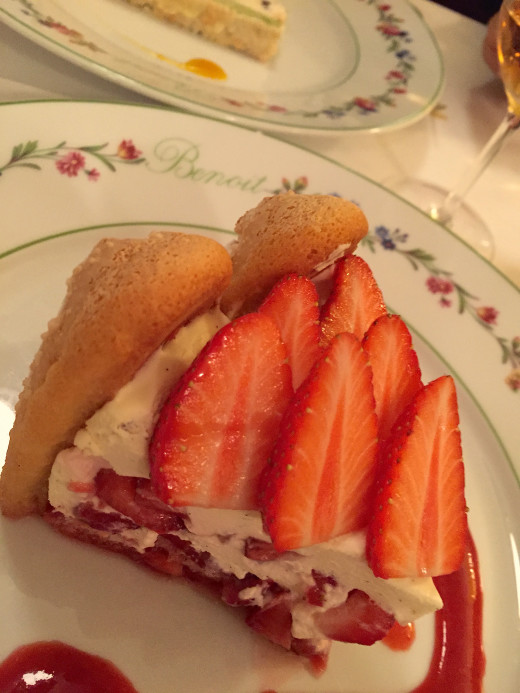
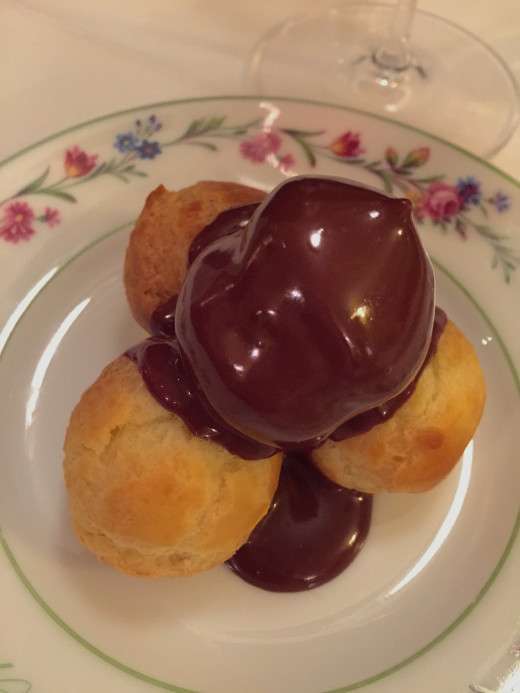
And then we finished up with an exquisitely made strawberry Charlotte, and a flirtatious little plate of chocolate-sauced napped profiteroles, which came to the table because the waiter liked us and wanted to please and provoke in equal measure. Our whole meal tasted of the food which made us decide to live our lives in Paris a longtime ago, but it was also fresher and more vivid than any of those remembered dishes of yore. This is where Ducasse, and chef Fabienne Eymard, have so admirably succeed, since there’s a very good possibility that the bistro cooking served here is even better today than it was when the Petits owned it. Memory is slippery by definition, but taste very rarely lies, because it’s so primal: Benoit is still a very good bistro.
20 rue Saint Martin, 4th Arrondissement, Paris, Tel. (33) 01-58-00-22-05. Metro: Chatelet or Hotel de Ville. Open daily for lunch and dinner. Lunch menu 39 Euros, Average a la carte dinner 85 Euros. www.benoit-paris.com




